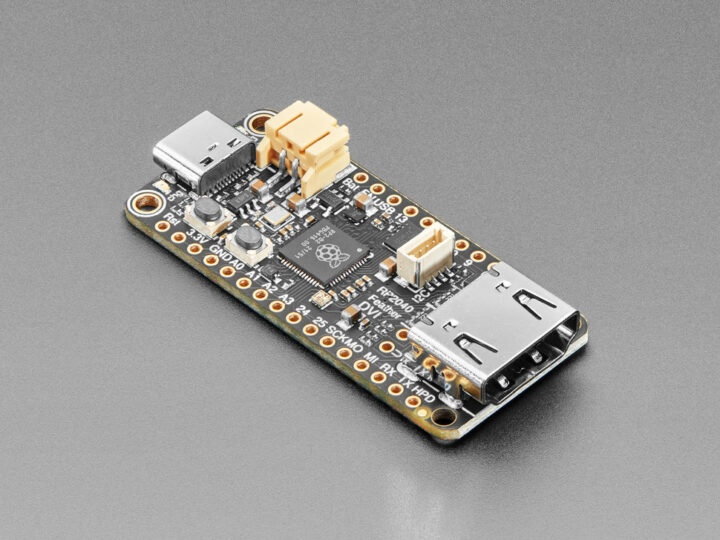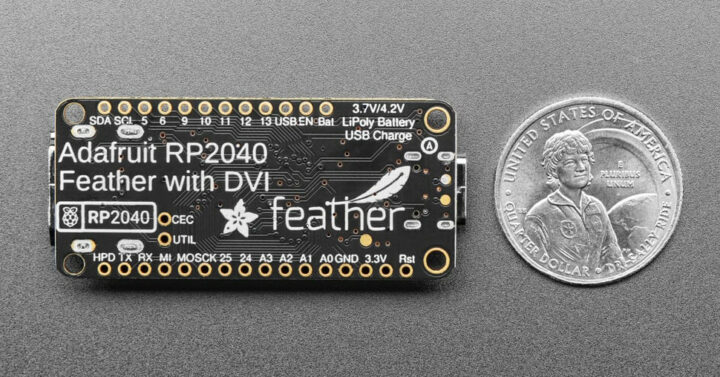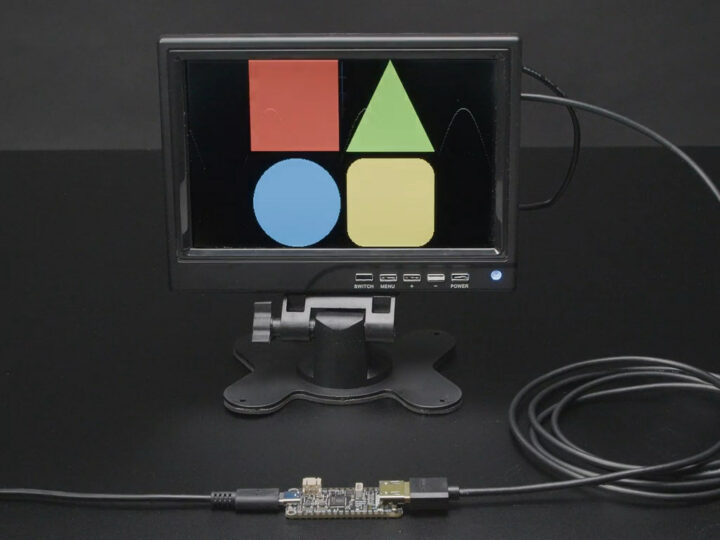“Adafruit Feather RP2040 with DVI Output Port” is another Raspberry Pi RP2040 board with an HDMI port that can output DVI video signal (no audio) to most TVs or monitors with an HDMI input port thanks to the PicoDVI project. The board builds upon the company’s Adafruit Feather RP2040 with the HDMI port adding just a few dollars.
Adafruit Feather RP2040 with DVI Output Port specifications:
- MCU – Raspberry Pi RP2040 dual-core Arm Cortex M0+ microcontroller ~125 MHz (but it should be overclocked for DVI output) with 264 KB RAM
- Storage – 8MB SPI flash
- Video Output – 1x HDMI port for DVI output up to 320×240 or 400×240 resolution with 16-bit pixels, I2C signals to read EDID data, plus CEC and Utility pads broken out
- USB – 1x USB Type-C port
- I/Os
- Adafruit Feather compatible headers
- Up to 21x GPIOs
- 2x I2C, 2x SPI, 2x UART
- 4x 12-bit ADC
- 16x PWM
- USB
- 3V, GND, BAT, Enable signals
- STEMMA QT/Qwiic I2C connector
- Adafruit Feather compatible headers
- Misc – BOOT and RESET buttons, user LED, charging status LED, Neopixel RGB LED
- Power Supply
- 5V via USB Type-C port
- 2-pin LiPo battery connector plus LiPo charger circuit with 200mA+ charging current
- 3.3V regulator with 500mA peak current output
- Dimensions – 53 x 23.3 x 7.7 mm (Adafruit Feather form factor)
- Weight – 7.2 grams
We’ve seen this type of board for a couple of years, including in the Olimex RP2040 Pico PC, and they work by using the PicoDVI project leveraging the fast programmable I/O (PIO) blocks found in the Raspberry Pi RP2040 microcontrollers. It’s possible to output to 640x480p 60 Hz DVI mode with the Cortex-M0+ cores overclocked at 252 MHz and 264KB RAM used.
Adafruit is a bit more conservative with the maximum resolutions as they only claim to support 320×240 (with 150KB RAM used) or 400×240 (with 190KB RAM used), because the higher resolution requires massively overclocking the microcontroller, and the RAM is fully utilized leaving no extra memory for some other code running on the Raspberry Pi RP2040 microcontroller. We’re also told the internal framebuffer is blitted out as pixel-doubled 640×480 or 800×480 digital video.
Adafruit already has a DVI video output solution for the RP2040 with the DVI breakout board for the original RP2040 Feather board, but the new board makes it even easier to use and smaller. Note that while Feather boards typically support CircuitPython, the forked PicoDVI library used with the board is only available in Arduino (recommended) and the Pico C SDK at this time. The instructions to get started and code samples can be found on Adafruit Learn.
Adafruit is selling the Adafruit Feather RP2040 with DVI Output Port for $14.95 plus shipping with around 40 boards in stock at the time of writing.

Jean-Luc started CNX Software in 2010 as a part-time endeavor, before quitting his job as a software engineering manager, and starting to write daily news, and reviews full time later in 2011.
Support CNX Software! Donate via cryptocurrencies, become a Patron on Patreon, or purchase goods on Amazon or Aliexpress








Strange having an hdmi on such a device, can’t realy see a proper use case for it..
It can be used to display trivial information in low-security places without fearing the device being stolen. E.g. time-of-day, temperature, number of attendees, free parking slots etc.